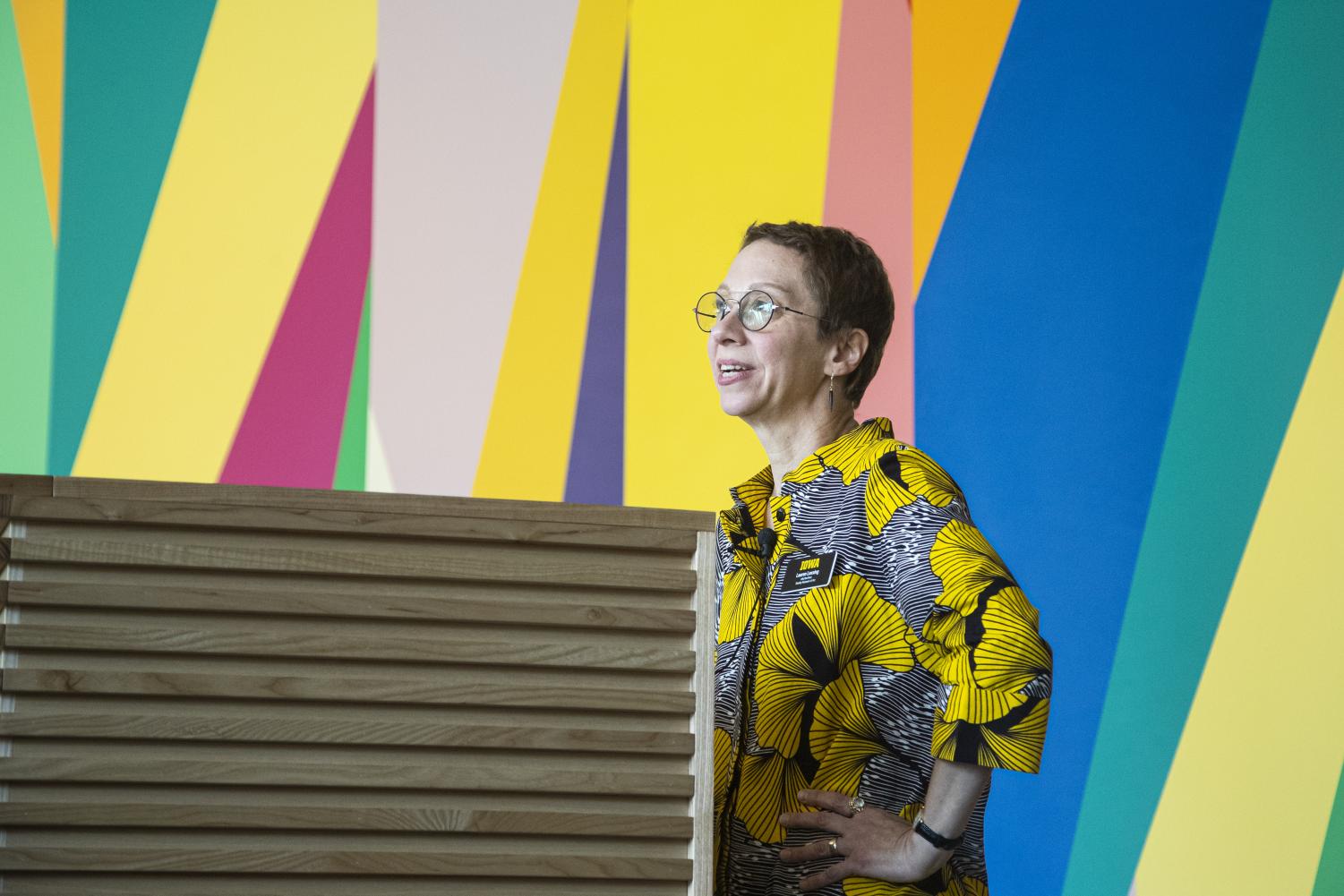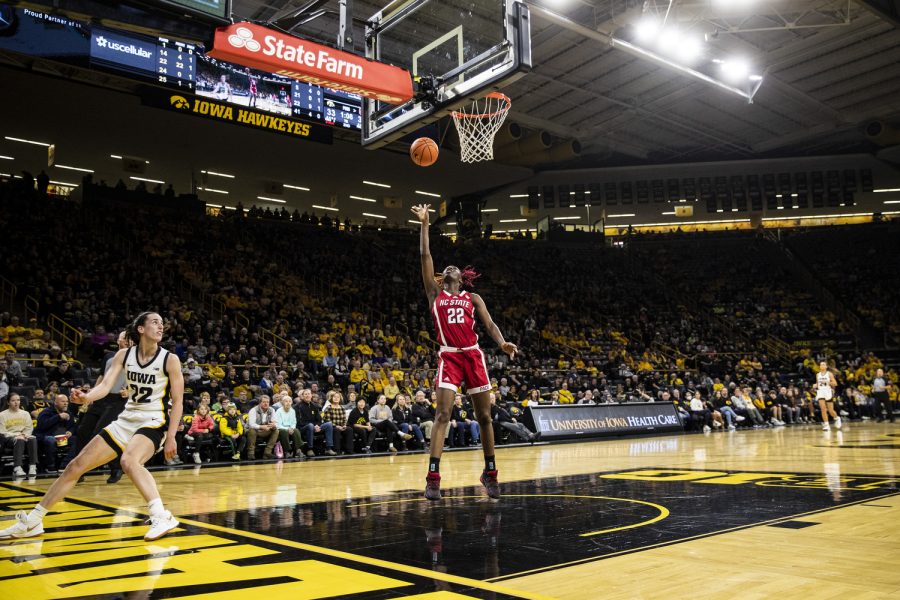New Stanley Museum staff plans for the future three months after ‘Homecoming’ exhibition
Three months after the opening of the historic Stanley Museum of Art, the new director and her staff plan for the future. Her initiatives include a new collection plan, increased engagement with students, and growing endowments.
November 29, 2022
An old man sits on a bench in front of the University of Iowa Stanley Museum of Art’s African art collection, sketching in a notebook perched on his lap. Inside, two teenagers with Iowa pins on their bags giggle as they dart through the exhibits before they stare at a sculpture by Elizabeth Catlett. Hushed whispers emanate from a crowd of people as they stare up at Jackson Pollock’s “Mural.”
Three months after patrons filled the new Stanley Museum for its grand opening, Director Lauren Lessing and her team are pushing for larger endowments and hope to foster closer relationships with the student body while promoting art and culture in the community.

Following the 2008 flood, the original Stanley Museum was rendered uninsurable. In the first month following the return of a physical building, the new Stanley Museum received a donation total of $18,457. This total is not reflective of the future gift commitments pledged by patrons after they were inspired by the museum’s opening.
Stanley Museum supporters donated over $25 million to contribute to the building costs. The museum also received a 300 percent increase in pledged donations in the first month of the building’s opening when compared to the same period last year.
“This is fertile ground,” Lessing said. “I have never lived in a place where there has been such strong and passionate support for the arts. And that is at every level, from the administration of the university, to the student body, to the people who live in the community.”
Three months after its opening, the Stanley Museum and its 13 full-time employees are shifting their focus toward the future.
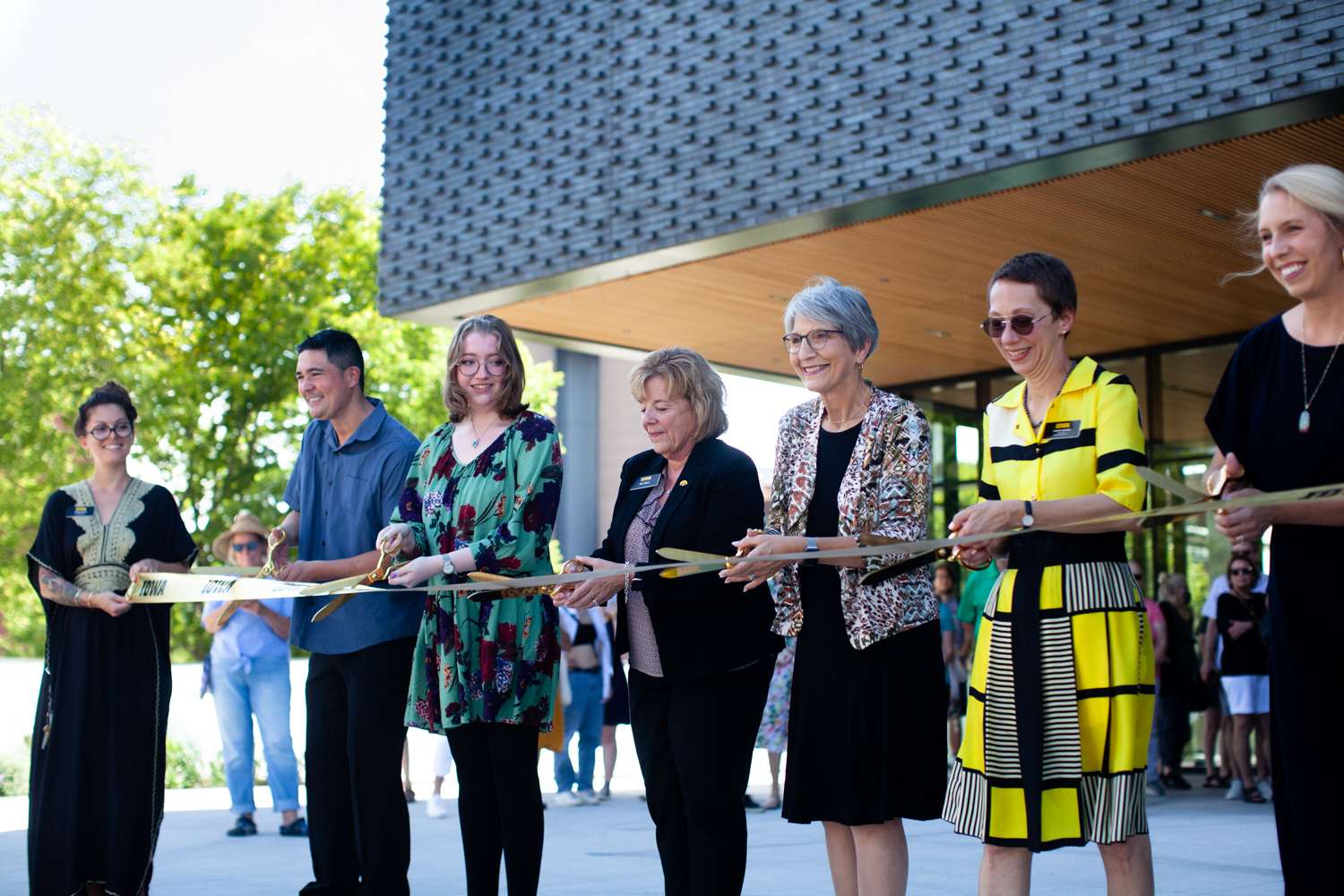
Sherry Bates, president pro tem of the state Board of Regents, University of Iowa president Barbara Wilson, Stanley Museum of Art Director Lauren Lessing and others cut a ribbon at the opening celebration for the Stanley Museum of Art at the University of Iowa on Friday, Aug. 26, 2022.
Leadership
The ninth director of the Stanley Museum grew up surrounded by art. Lessing was raised in southern Indiana, just across the river from Louisville, Kentucky. Her mother was a painter and a high school art teacher. Her father was a sculptor and the art director for Bruce Fox: a small company that created decorative, cast-metal artworks for Wilton and other brands.
“I grew up watching my parents make things,” Lessing said. “They had studied at the University of Louisville, right after the Second World War.”
It was there that her parents studied painting from an internationally recognized artist, Ulfert Wilke.
Wilke later left the University of Louisville and came to the UI. With Wilke, the UI opened the UI Museum of Art, now known as the Stanley Museum of Art. He was the first director of the museum and held the position that Lessing now holds.
Lessing was present for the museum’s opening as a baby, further connecting her to its history. Her parents kept in touch with Wilke through letters during his lifetime, and she remembers him as a family friend.
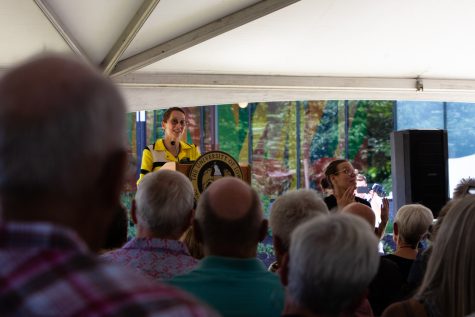
Lessing’s childhood experiences helped her transition to over a 25-year-long career in art history and education. Her credentials include working for museums such as the Art Institute of Chicago and the Nelson-Atkins Museum of Art in Kansas City, Missouri.
Before her arrival at the UI, Lessing worked at the Colby College Museum of Art as the Mirken Director of Academic and Public Programs in Waterville, Maine. While there, she learned of the flood that swept through Iowa City in 2008.
The waters damaged the original Stanley Museum, though the artwork was salvaged due to the efforts of employees and over 200 volunteers. Thousands of pieces of art were evacuated before they were dispersed to the IMU, the Figge Museum in Davenport, and other collections around the country.
Through her family connections, Lessing had an already established love for the UI.
“That was what made the flood so devastating for me when I saw everything happening from Maine,” Lessing said.
Ten years later, Lessing would become the ninth director of the Stanley Museum of Art, assuming the same position Wilke occupied in her childhood. Under her guidance, she doubled her staff and oversaw the opening of the $50 million dollar new facility on Burlington St.
“We had reconfigured ourselves to be a museum without walls,” Lessing said. “We were not used to thinking about the mission of the museum and the way we would need to pivot and think about it once we were in a building.”
Two months after the museum opening, Lessing has shifted her focus toward securing permanent lines of funding for three of her staff members. Currently, those positions are supported using funds raised for the museum by the UI Center for Advancement.
“I didn’t even take a breath,” Lessing said. “I pivoted right from the building campaign to raising money for operations.”
Lessing said while the 17,000-item collection of the museum is extensive, its staff is the smallest of the Big Ten. Additionally, while other Big Ten Museums, like Northwestern’s Block Art Museum, have an endowment of nearly $18 million, Stanley Art Museum has an endowment of around $5 million.
Lessing’s biggest goal over the next ten years is to triple the size of that endowment and double her staff to support the Stanley’s sizable collection. With that increase, staff funding will expand, as will support for teaching, learning, and research.
“We’re a young art museum,” Lessing said. “We’ve only been around since 1969. And it takes time to build up endowment funds so we can begin to build our capacity to do some of the things that we know we want to do.”
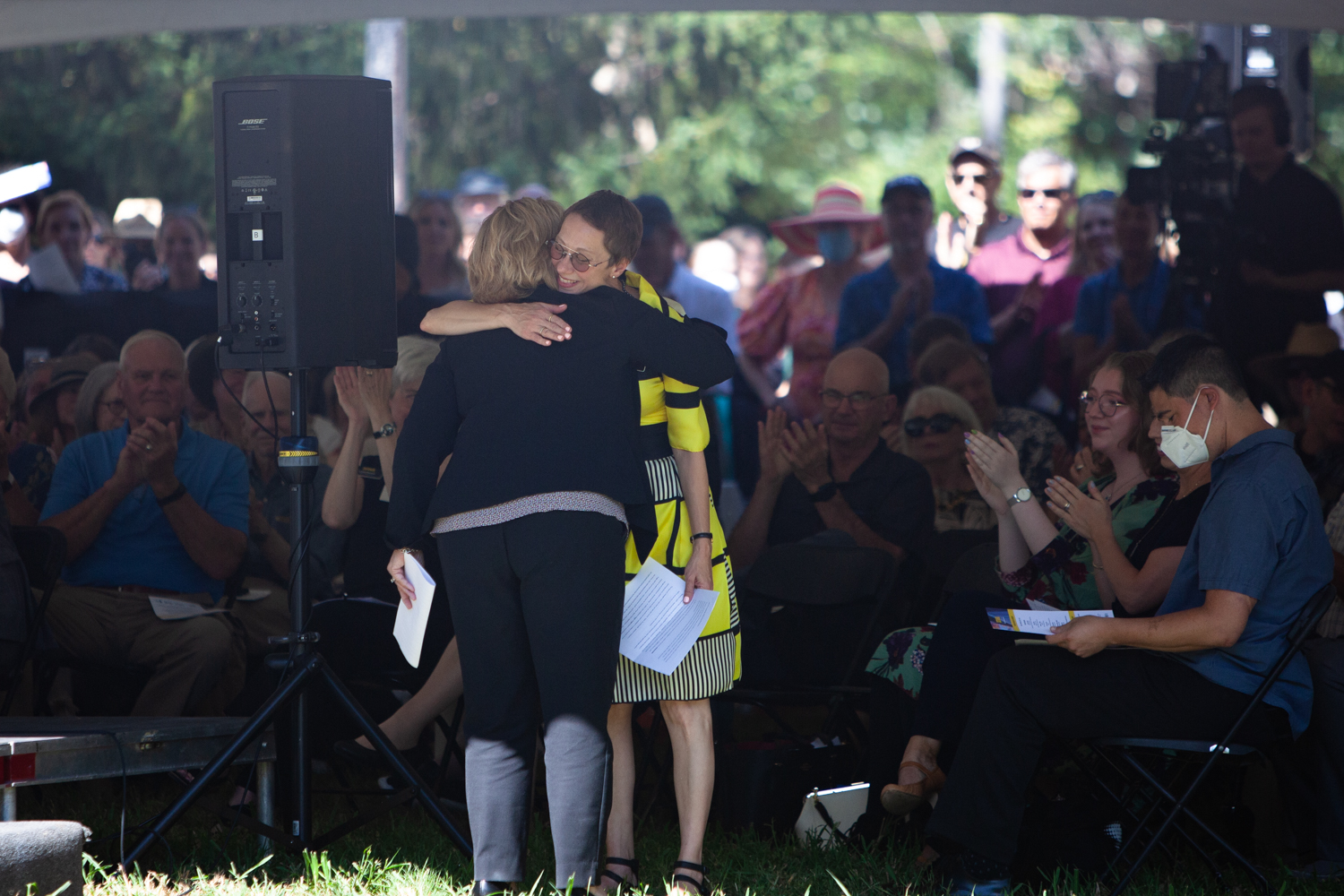
University of Iowa president Barbara Wilson hugs Stanley Museum of Art director Lauren Lessing at the opening celebration for the Stanley Museum of Art at the University of Iowa on Friday, Aug. 26, 2022.
Engagement
From the museum’s new location between the Main Library and the campus recreation center, the building is a newly-minted staple for Iowa City architecture.
“It’s not quiet,” Tokarski said. “The visibility is really cool of this building and I think it does more of a service to the collection than the old space did.”
From her position on the third floor of the Stanley Museum, Tokarski’s window overlooks the riverbanks and water treatment plant that divides the campus in half. Her office overflowed with stacks of books, papers, and boxes, but the brightly-colored posters that show various works of art offered visitors a homey feeling.
Tokarski’s position was created to be a resource for students on campus to connect with the new Stanley. With the return of the building to a prominent place on campus and a growing staff, Tokarski’s role was created in April to be a resource for student engagement.
“It is a new job developed with the opening of the museum in mind,” Tokarski said. “So a lot of the work I do is creating experiences for University of Iowa students at the Stanley… I focus more on getting them involved in different ways.”
Increasing student engagement on campus, Lessing said, is another one of the major goals for the museum as they move forward during the next ten years. Tokarski’s role helps foster those connections within the student body.
Her role includes assisting with a student advisory group, monthly events, and weekly mindfulness activities in the museum. Tokarski also plans to begin a student docent program next fall, allowing more students within different disciplines to be more involved with teaching and learning from the collection.
It is an experience Tokarski had herself as a student. In 2016, Tokarski worked as a gallery host for the Stanley Museum located in the Iowa Memorial Union. This location offered small sections of the collection to tour, though the space was limited.
Tokarski graduated with her BFA in Painting in 2019 and continued to work at the museum until the pandemic shut Stanley’s doors in 2020. When she was offered the role to assist with student engagement in 2022, she seized the opportunity to give back.
“I feel like it’s sort of my duty,” Tokarski said. “The Stanley did so much for me as a student. I was able and lucky to have and seek out those opportunities… Giving as many students as possible the same opportunity is the ultimate goal moving forward.”
Tokarski is not the only member of staff focused on engagement. In another new position, Learning and Engagement Team academic outreach coordinator Kathryn Reuter leads class and faculty tours around the museum every week.
“It’s kind of like, wow, let’s talk about the past,” Reuter said. “And maybe not all the students are jazzed to talk about history. It’s not everyone’s favorite subject. So I try to make it relevant and engaging to the content they are learning in class.”
In her position, Reuter splits her time between the museum, where she spends forty percent of her time, and UI Special Collections. This integration offers an overlap between the collections, especially when both collections have work by the same artist.
Access to these collections is something Reuter values highly. The museum does not ask for an entrance fee when visitors arrive and instead relies on donations and grants to survive. This is an aspect that allows the museum to be receptive to incoming audiences from different backgrounds.
As a child, Reuter grew up in Orange County, California, and identified as low-income. Her past experiences influenced her appreciation for the free access to the collection.
“[As a child] even when I entered a lot of museums, I had that feeling of, this space is not for me,” Reuter said. “It is a space for people who are fancier than I am and come from a different home than the one I came from.”
Reuter said that museum fees can be an especially strong barrier for those who hope to visit, so she was excited to hear that the Stanley offered free admission.
In her role, Reuter said she hopes to continue fostering relationships with the community, even beyond the UI.
“You should feel welcome at the Stanley Museum,” Reuter said. “It really is for everybody.”
Czinano continues to struggle
NC State guard Saniya Rivers goes up for a shot during a women’s basketball game between No. 10 Iowa and No. 12 NC State at Carver-Hawkeye Arena in Iowa City on Thursday, Dec. 1, 2022. Rivers shot 9-of-11 in field goals. Both Rivers and guard Diamond Johnson scored 22 points for NC State. The Wolfpack defeated the Hawkeyes, 94-81.
Senior center Monika Czinano did not record a point in the first half against NC State on Thursday night and took just one shot.
Czinano finished the game with only five points on 2-of-4 shooting from the field.
“That was a focus in practice,” NC State guard Diamond Johnson said of guarding Czinano. “We knew how good she was, how efficient she was, and if she was going to take a shot there’s a good chance that it’s going in.”
Czinano has been struggling to get shots off in recent games, as she recorded just seven points on eight shots against UConn on Nov. 27.
“This was a totally different defense than what UConn did to us,” Bluder said. “I don’t know why we couldn’t get her the ball tonight, honestly. I mean, they were on her back. Why can’t we pass the ball to the post when the post defense is on her back? It’s maddening.”
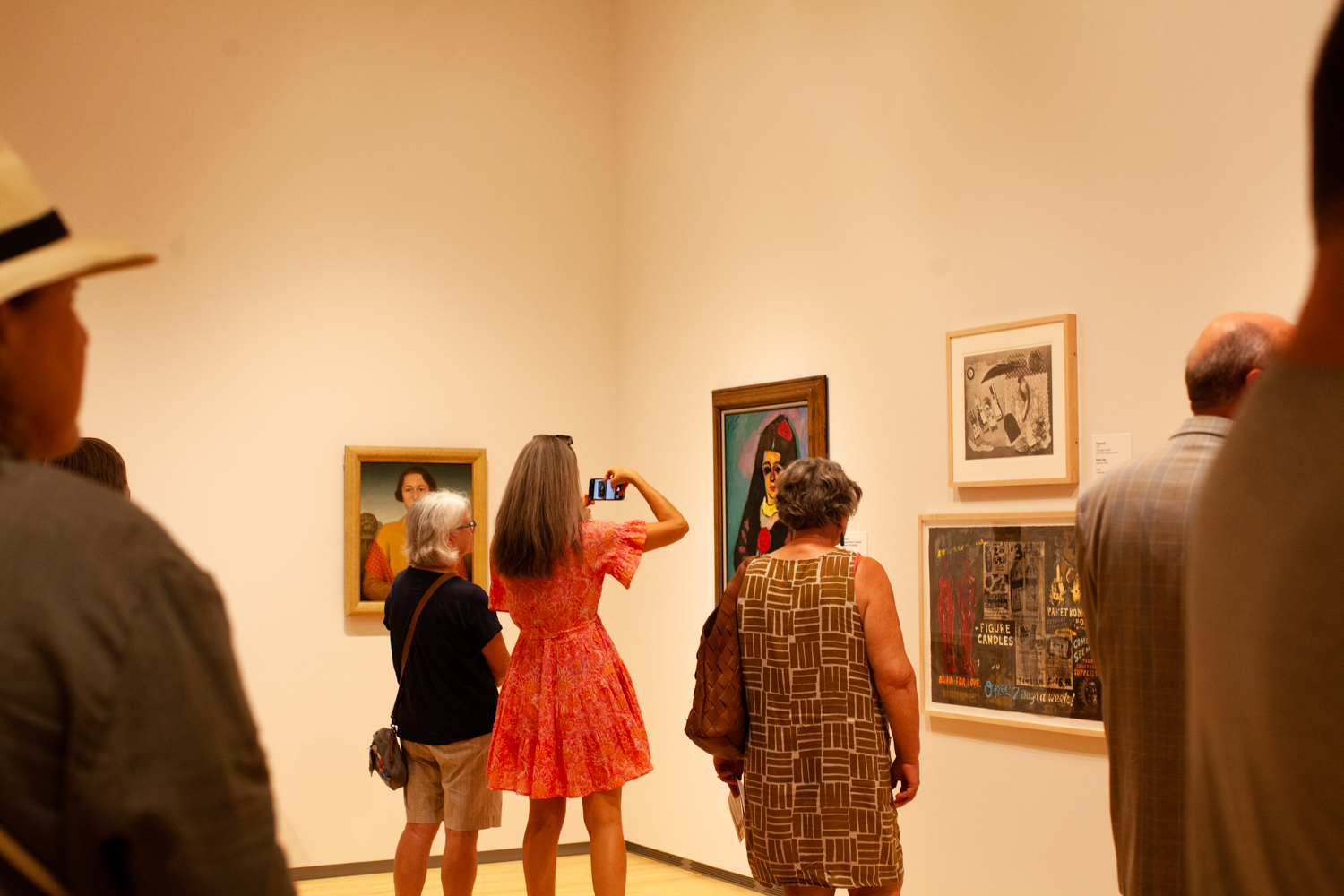
People take photos of exhibits in the Stanley Museum of Art at its opening celebration at the University of Iowa on Friday, Aug. 26, 2022.
Moving forward
Within the mix of the museum’s 17,000-object collection are paintings, photographs, sculptures, and more. But there are other, stranger pieces that have not seen daylight for years. Novelty liquor bottles, Zippo lighters, and cuckoo clocks are just a few of the wide array of items that have made their way into the collection.
“These are some amazing things, but they don’t necessarily belong in an art museum collection,” Lessing said.
Until 2020, the museum did not have a collection plan: a type of detailed outline that highlights what the museum does and does not collect. As a result, the items became more eclectic.
Over the next 10 years, the Stanley Museum plans to assess the items in its collections and sell those non-art items that do not belong within the new museum. Additionally, Lessing pointed out gaps in the collection that the museum intends to fill.
The inaugural Homecoming exhibition increased representation by acquiring more diverse work through loans and strategic acquisitions, but Lessing said she hopes to build an even more diverse permanent collection over the next decade.
This would include more works by women, contemporary indigenous artists, Black photographers, and alumni.
“It’s a thrill to be a part of this,” Lessing said. “It’s a very, very deep honor.”
